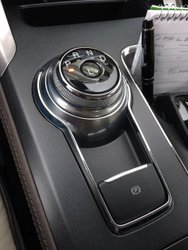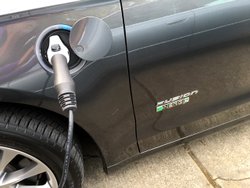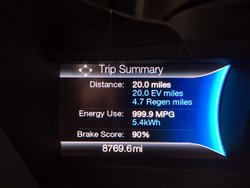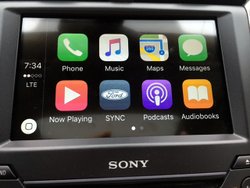Green and Greener
Ford’s Fusion has taken over a traditional role at Ford—that of the best-selling car. For those who don’t savor driving a crossover or SUV, the midsize sedan segment remains popular and includes such perennial bestsellers as the Toyota Camry, Honda Accord and Nissan Altima.

The Fusion remains attractive, so I assume that Ford realized that when they doled out only modest midcycle updates. Outside, the front end gets sharpened while the taillamps become connected by a chrome bar, but otherwise things remain about the same. Inside, the transmission control is transformed into a finely rendered disc, like a small, thick hockey puck, much like the one in Jaguars and Land Rovers, but without the clever rising effect found in those luxury makes.
This American-brand car, built in Mexico, comes in a variety of flavors, but let’s look at the two greenest ones—the Hybrid and the Energi.
The Ford Fusion Hybrid

The 2017 Fusion Hybrid combines a 2.0-liter four-cylinder engine with an electric motor for a total of 188 horsepower and 129 pounds-feet of torque. Like a good hybrid, the Fusion moves between these two energy sources automatically, depending on driving conditions and driver input. Take it easy on the accelerator and you’ll find the Hybrid remains more in electric mode. Climb a hill and you’ll hear the engine kick in. On downhill descents, the battery charges silently.
This behavior nets you EPA numbers of 43 city/41 highway/42 combined. Compare these with the Toyota Camry Hybrid’s 38 mpg and Honda Accord Hybrid’s 48 combined scores. My Blue Lightning test car averaged 41.0 mpg during its test week.
The Ford Fusion Energi
Choosing the 2017 Ford Energi model adds a major new element into the picture. With its 7.6 kWh battery, this Fusion can run as a pure electric vehicle for an EPA rated 22 miles. That meant that when I took my 18-mile-each-way commute in the Energy, I made it just about door-to-door without using a drop of gas.

With the variety in traffic conditions, on a few days I pulled up to the charger at work with a little juice left. The Energi’s EPA ratings, for MPGe this time, are 97 MPGe, or 35 kWh per 100 miles (compare this with other plugin hybrids). The gauge in my Magnetic Metallic (gray) test car read 101.4 MPGe at the end of my test week, and the gas gauge had hardly budged from full.
What’s the Same; What’s Different
Driving the cars feels about the same, except that the Energi is smoother and quieter longer, since an entire trip may not use the gasoline engine at all. The Energi weighs 298 pounds more than the Hybrid (3,913 vs. 3,615 pounds), and its trunk is shortened to accommodate its larger battery (the Hybrid’s smaller battery, without charging ability, has only a 1.4 kWh capacity).

EPA Green ratings are a very good 8 for Smog and 9 for Greenhouse gas for the Hybrid and 8 and 10 respectively for the Energi. More numbers: the CO2 grams-per-mile output of the Energi runs about half the Hybrid—110 vs. 210.
When you drive the Hybrid, you can set the center screen to show you one of the car’s three driving modes. Under the right conditions, you’re in Electric Drive mode, using no gasoline. When the engine engages, you’re in Hybrid Drive mode, where the engine and motor work together. If you’re generating electricity, you’re in “Recharging High Voltage Battery” mode. These switched back and forth as I drove.
Both cars’ instrument panels provide a bar chart of driving behavior, including acceleration, braking and cruising. Depending on road and traffic conditions, sometimes one or the other metrics dipped into the negative “yellow” condition, but normally they showed the desired blue.
The Levels and Their Costs
Fusions come in different equipment levels, ranging from S to SE to Titanium to Platinum. You can get a regular non-hybrid version, too. My Hybrid wore the Titanium nameplate while the Energi flaunted the top-level Platinum badge on its tail. The Platinum level borders on the luxurious, featuring soft, quilted leather on the seats and doors, among other upgrades.

With $3,760 worth of style and safety options, the Hybrid came to $35,155, including destination and delivery. The Energi, with no extras and with the “Fusion Energi Discount,” rolled in at $39,995.
Interestingly, the annual fuel cost on the window stickers was $900 for the Hybrid and $800 for the Energi. So, your benefits here become less financial and more about environmental impact. There is no pure electric Fusion for sale now, but if industry trends pan out, there could be in the future. For now, if you’re a commuter, you may find the extra cost of the Energi really pays off.
If you want an attractive, comfortable sedan with a little greener perspective, try one of Ford’s two greener Fusions.
Related Stories You Might Enjoy:
Road Test: 2017 Ford Fusion Energi
Road Test: 2017 Toyota Camry Hybrid
Road Test: 2017 Honda Accord Hybrid
First Drive: 2016 Nissan Altima
Disclosure:
Clean Fleet Report is loaned free test vehicles from automakers to evaluate, typically for a week at a time. Our road tests are based on this one-week drive of a new vehicle. Because of this we don’t address issues such as long-term reliability or total cost of ownership. In addition we are often invited to manufacturer events highlighting new vehicles or technology. As part of these events we may be offered free transportation, lodging or meals. We do our best to present our unvarnished evaluations of vehicles and news irrespective of these inducements.
Our focus is on vehicles that offer the best fuel economy in their class, which leads us to emphasize electric cars, plug-in hybrids, hybrids and diesels. We also feature those efficient gas-powered vehicles that are among the top mpg vehicles in their class. In addition, we aim to offer reviews and news on advanced technology and the alternative fuel vehicle market. We welcome any feedback from vehicle owners and are dedicated to providing a forum for alternative viewpoints. Please let us know your views at publisher@cleanfleetreport.com.

11 thoughts on “Comparison Test: 2017 Ford Fusion Hybrid and Energi”